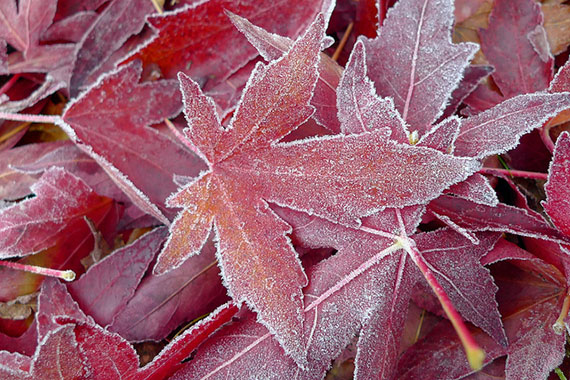In previous articles we’ve considered photography tips using water as an ideal photo subject during warm seasons when it involves waves, waterscapes, waterfalls, reflections, abstracts, spray ‘n splash, bubbles ‘n foam, puddles, condensation, hail, mist and fog to help us out of the photo doldrums. Now, let’s consider some of its cold season photo ops for doing that.

photo by Paxson Woelber
Water is unique because it can be found in all three basic states: vapor, liquid and solid. In the cold seasons, when it can turn crystalline or solid, is when it can produce truly fascinating and amazing pictures. Here are some photography tips for that season:
Frost
Frost transforms things into artwork. On leaves and vegetation, subtle edge and vein patterns stand out boldly as intriguing designs. On window panes frost patterns can be fascinating. Again, it’s mainly a matter of checking out your local weather forecast, knowing your surroundings, what to expect, and getting there with your camera before it melts!
Ice

photo by Kasia
If there are puddles, or a pond or lake nearby check out the edges when the water freezes. There will be ice captives—leaves and twigs—just below the surface encased in the ice, sometimes with air bubbles and patterns in the ice itself. Just be careful about thin ice and how far out on the ice you venture when taking such pictures!
Re-Freeze
Here is a special ice situation to look out for: it snows, then turns mild and rainy, then suddenly cold snaps. Check out the depressions and roadside ditches. The snow has been ‘sculptured’ by the melt and run-off, then encased (along with leaves, etc.) in the clear ice from the rain and cold snap, producing some very unusual subjects.
Tenacious Grace
Is there a lively stream or brook nearby, one which tumbles and bubbles over stones, rocks or fallen trees and branches, generating splash and spray? When the temperature drops well below freezing you’ll find a delicate embroidery-like ice (hence the name) forms on the edges of things from the spray.

photo by Justin Fincher
Self-Assignments For Above Photography Tips
Choose the projects that interest you most. Follow the photography tips conscientiously. Re-shoot when you aren’t satisfied. Do it until you are satisfied. It’ll take all your patience and passion. Your skills and eye will improve with the practice. Shoot especially in early and late light. Use a tripod as much as possible. Edit your results relentlessly. Pin small samples on the wall for a few days to study before making final prints for wall art.
Frost
During winter cold-spells choose a window that faces the rising sun and place a humidifier in front of it. Open the inner window about ¼” to let warm moist room air enter and contact the outer window to form jack frost on it. Take pictures as the sun rises and shines through the frost.
In late fall and early spring when the forecast predicts frost, get outside early and look for fallen leaves and grasses with frost on them. Take pictures.

Photo by Ruth Hartnup; ISO 80, f/2.0, 1/100-second exposure.
Ice
When it’s cold enough for ice to form, locate some large puddles or a pond and look for “ice captives” (leaves) just under the ice surface, and take pictures of them through the ice.
Re-freeze
When the weather does a snowfall, then a thaw with rain, then a re-freeze, get outside and check the depressions and roadside ditches for snow swirls under clear ice with leaves, etc., caught in it and take pictures.
Tenacious Grace
When the weather turns really cold, locate a nearby stream that briskly tumbles over rock piles and branch jams and you’ll find ‘Grace’. Find a pleasing section of it with water running by it and shoot with a slow shutter speed to blur the water in contrast to the sharply detailed ice.
In this set of articles we consider more photography tips on cold season photo op’s that water can provide for overcoming the photo doldrums: icy streams, freezing rain, icicles and snowflakes.
About the Author:
John Maxymuik from AmbienceImages authored this article which is part of a 6-piece set of Photography Tips for the Photo Doldrums providing tips to break the grip of the photo doldrums using the “ideal photo subject”.
Like This Article?
Don't Miss The Next One!
Join over 100,000 photographers of all experience levels who receive our free photography tips and articles to stay current:






wonderful points altogether, you just gained a
emblem new reader. What could you recommend about your put up that you just made some days ago?
Any positive?
I post a bi-weekly list of tips, tricks and tutorials in the photography field. May I link to this post?